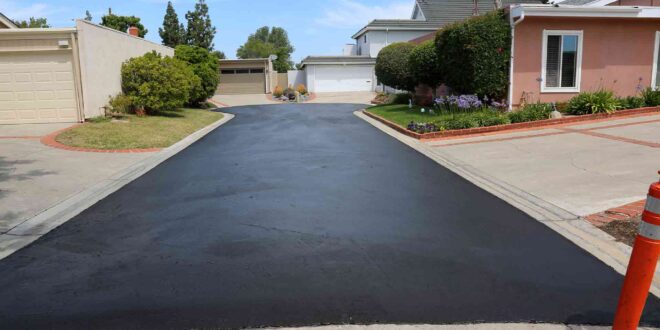Tarmac driveways are a popular choice among homeowners in Bournemouth, thanks to their durability, affordability, and sleek appearance. Whether you’re looking to improve the curb appeal of your property or simply need a reliable and long-lasting driveway, tarmac is a fantastic option. However, like any significant home improvement project, installing a tarmac driveway requires careful planning and execution.
In this ultimate guide, we’ll walk you through the essential steps involved in the installation process, from initial planning to the final touches. By the end of this guide, you’ll have a clear understanding of what to expect and how to ensure a successful tarmac driveway installation in Bournemouth.
1. Planning and Preparation
Before breaking ground on your new driveway, it’s crucial to spend some time on planning and preparation. The first step is to assess your property’s needs and determine the scope of the project. Consider the following factors:
- Driveway Size and Shape: The size and shape of your driveway will depend on your property’s layout and your personal preferences. A larger driveway will require more materials and labor, so it’s important to balance your needs with your budget.
- Drainage Requirements: Proper drainage is essential to prevent water from pooling on your driveway, which can lead to cracks and damage over time. Assess the natural slope of your property and plan for appropriate drainage solutions.
- Permits and Regulations: In some cases, you may need to obtain permits or adhere to local regulations before installing a new driveway. Check with your local council to ensure compliance with any rules or restrictions.
Once you’ve defined the scope of your project, it’s time to choose a reputable contractor. When searching for experts in tarmac driveways Bournemouth, look for professionals with a proven track record, positive reviews, and appropriate licensing and insurance. A good contractor will also provide a detailed quote and timeline for the project.
2. Excavation and Groundwork
The first physical step in the installation process is excavation and groundwork. This involves removing any existing driveway surface, vegetation, or soil to create a stable base for the tarmac. Proper excavation is crucial for the longevity of your driveway, as it ensures that the surface will be level and well-drained.
- Site Clearing: The area where the driveway will be installed must be cleared of all debris, including old pavement, grass, and rocks. This ensures a clean slate for the new tarmac.
- Excavation: The excavation depth will depend on the type of soil and the intended use of the driveway. Typically, a depth of 150-200mm is sufficient for most residential driveways. If heavy vehicles will be using the driveway, deeper excavation may be necessary.
- Sub-Base Installation: A sub-base is a layer of compacted material, usually crushed stone or gravel, that provides a stable foundation for the tarmac. The sub-base should be evenly distributed and compacted to prevent future settling and ensure proper drainage.
Proper groundwork is essential to the success of your tarmac driveways Bournemouth installation. Skipping or rushing this step can lead to problems down the line, such as cracking, sinking, or drainage issues.
3. Laying the Tarmac
With the groundwork complete, it’s time to lay the tarmac. This step requires precision and expertise to ensure a smooth, even surface that will stand the test of time.
- Base Layer: The first layer of tarmac, known as the base course, is laid directly on top of the sub-base. This layer is typically made of coarse, aggregate-rich tarmac and provides structural support for the driveway.
- Compaction: Once the base layer is laid, it must be compacted using a heavy roller to ensure a solid, even surface. Proper compaction is key to preventing future cracking or settling.
- Wearing Course: The top layer of tarmac, known as the wearing course, is then applied over the compacted base layer. This layer is finer and smoother, providing a polished finish that enhances the driveway’s appearance.
- Final Compaction: After the wearing course is laid, it is compacted once more to create a uniform, durable surface. The edges of the driveway are also sealed to prevent water ingress and improve the driveway’s overall stability.
The entire process of laying the tarmac typically takes a few days, depending on the size of the driveway and the weather conditions. It’s important to allow each layer of tarmac to cool and set properly before moving on to the next step.
4. Curing and Finishing Touches
After the tarmac is laid and compacted, it needs time to cure. Curing allows the tarmac to harden and reach its full strength, which is essential for its long-term durability.
- Curing Time: Tarmac usually takes 24-48 hours to cure enough for light use, such as walking or parking small vehicles. However, it’s best to wait at least 7 days before subjecting the driveway to heavy vehicles or equipment.
- Edging and Borders: To give your driveway a polished look, consider adding edging or borders. This can be done using materials like bricks, stones, or concrete. Edging not only enhances the driveway’s appearance but also helps to prevent the tarmac from spreading or cracking.
- Sealing: While not always necessary, applying a sealant to the surface of the tarmac can help protect it from UV rays, water damage, and staining. Sealing should be done after the tarmac has fully cured, usually several weeks after installation.
Proper curing and finishing are crucial for ensuring the longevity and appearance of your tarmac driveways Bournemouth. Skipping these steps or rushing the process can result in a driveway that doesn’t perform as expected.
5. Maintenance Tips
Once your tarmac driveway is installed and cured, it’s important to keep up with regular maintenance to ensure its longevity.
- Regular Cleaning: Sweep the driveway regularly to remove debris and prevent the buildup of dirt and grime. Pressure washing can also help remove stubborn stains.
- Prompt Repairs: If you notice any cracks or damage, address them promptly to prevent further deterioration. Small cracks can often be repaired with a tarmac filler, while larger issues may require professional attention.
- Avoid Heavy Loads: While tarmac is durable, it’s still a good idea to avoid parking heavy vehicles or equipment on the driveway for extended periods, as this can cause indentations or damage.
By following these maintenance tips, you can keep your tarmac driveways Bournemouth looking great and performing well for years to come.
Conclusion
Installing a tarmac driveway is a significant investment that can greatly enhance the curb appeal and functionality of your property. By following the steps outlined in this guide, you can ensure a smooth and successful installation process. From careful planning and excavation to precise tarmac laying and proper maintenance, each step is crucial for achieving a durable and attractive driveway.
Whether you’re upgrading your existing driveway or installing a new one, tarmac driveways Bournemouth offer a reliable and cost-effective solution that will serve your home well for many years. Read More
 Personal Finance and Attractive Interest Rates Unlock Smart Savings with Low Rates and Expert Financial Tips
Personal Finance and Attractive Interest Rates Unlock Smart Savings with Low Rates and Expert Financial Tips







